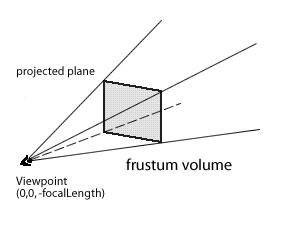The PerspectiveProjection class provides an easy way to assign or modify the perspective
transformations of a display object and all of its children. For more complex or custom
perspective transformations, use the Matrix3D class. While the PerspectiveProjection class
provides basic three-dimensional presentation properties, the Matrix3D class provides more
detailed control over the three-dimensional presentation of display objects.
Projection is a way of representing a three-dimensional object in a two-dimensional space, like a cube projected onto a computer screen. Perspective projection uses a viewing frustum (a rectangular pyramid) to model and project a three-dimensional world and its objects on the screen. The viewing frustum becomes increasingly wider as it moves further from the origin of the viewpoint. The origin of the viewpoint could be a camera or the eyes of an observer facing the screen. The projected perspective produces the illusion of three dimensions with depth and distance, where the objects closer to the screen appear larger than the objects farther from the screen.

A default PerspectiveProjection object is a framework defined for perspective transformation of
the root object, based on the field of view and aspect ratio (dimensions) of the stage.
The projection center, the vanishing point, is set to the center of the stage, which means the
three-dimensional display objects disappear toward the center of the stage as they move
back in the z axis. The default viewpoint is at point (0,0) looking down the positive z axis.
The y-axis points down toward the bottom of the screen. You can gain access to the root display
object's perspective projection settings and change the field of view and projection center
properties of the perspectiveProjection property through the root object's DisplayObject.transform
property.
You can also set a different perspective projection setting for a display object through the parent's
perspective projection. First, create a PerspectiveProjection object and set its fieldOfView and
projectionCenter properties. Next, assign the PerspectiveProjection object to the parent display
object using the DisplayObject.transform property. The specified projection matrix and transformation
will then apply to all the display object's three-dimensional children.
Constructor
Variables
fieldOfView:Float
Specifies an angle, as a degree between 0 and 180, for the field of view in three dimensions. This value determines how strong the perspective transformation and distortion apply to a three-dimensional display object with a non-zero z-coordinate.
A degree close to 0 means that the screen's two-dimensional x- and y-coordinates are roughly the same as the three-dimensional x-, y-, and z-coordinates with little or no distortion. In other words, for a small angle, a display object moving down the z axis appears to stay near the same size and moves little.
A value close to 180 degrees results in a fisheye lens effect: positions with a z value smaller than 0 are magnified, while positions with a z value larger than 0 are minimized. With a large angle, a display object moving down the z axis appears to change size quickly and moves a great distance. If the field of view is set to 0 or 180, nothing is seen on the screen.
focalLength:Float
The distance between the eye or the viewpoint's origin (0,0,0) and the display object located
in the z axis. During the perspective transformation, the focalLength is calculated dynamically
using the angle of the field of view and the stage's aspect ratio (stage width divided by stage height).
projectionCenter:Point
A two-dimensional point representing the center of the projection, the vanishing point for the display object.
The projectionCenter property is an offset to the default registration point that is the upper left of the stage, point (0,0). The default projection transformation center is in the middle of the stage, which means the three-dimensional display objects disappear toward the center of the stage as they move backwards in the z axis.
Methods
toMatrix3D():Matrix3D
Returns the underlying Matrix3D object of the display object.
A display object, like the root object, can have a PerspectiveProjection object without needing a Matrix3D
property defined for its transformations. In fact, use either a PerspectiveProjection or a Matrix3D object
to specify the perspective transformation. If when using the PerspectiveProjection object, a Matrix3D
object was needed, the toMatrix3D() method can retrieve the underlying Matrix3D object of the display object.
For example, the toMatrix3D() method can be used with the Utils3D.projectVectors() method.
Returns:
The underlying Matrix3D object.
toMatrix3DToOutput(output:Matrix3D):Matrix3D
Returns the underlying Matrix3D object of the display object.
A display object, like the root object, can have a PerspectiveProjection object without needing a Matrix3D
property defined for its transformations. In fact, use either a PerspectiveProjection or a Matrix3D object
to specify the perspective transformation. If when using the PerspectiveProjection object, a Matrix3D
object was needed, the toMatrix3D() method can retrieve the underlying Matrix3D object of the display object.
For example, the toMatrix3D() method can be used with the Utils3D.projectVectors() method.
Parameters:
output | An optional Matrix3D to be set to the underlying Matrix3D, avoiding the creation of a new object. |
|---|
Returns:
The underlying Matrix3D object.